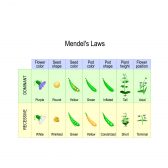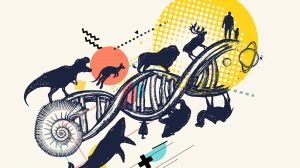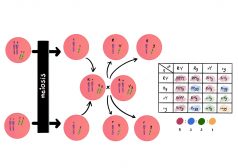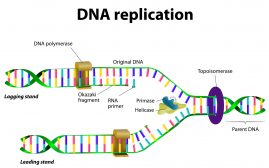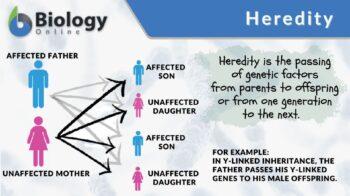
Heredity
n., plural: Heredities
[həˈɹɛɾəɾi]
Definition: biological inheritance
Table of Contents
Heredity Definition
In biology, heredity refers to the passing of genetic factors from parents to offspring or from one generation to the next. The biological definition of heredity may also pertain to the association of a particular trait with the genetic constitution of an individual organism, rather than with environmental conditions.
Brown eyes are inherited; a sunburn is acquired. The term came from the Latin hērēditāt, which in English means “inheritance”. Thus, heredity is a synonym for biological inheritance. The term “hereditary” is a related word; it is used to describe or relate to “heredity”. Synonyms: (biological) inheritance.
Codominance is an example of a form of biological inheritance. Come and join our Forum to learn more about it: What is the key to the recognition of codominance?
Principles of Heredity
Gregor Mendel, an Austrian monk, is considered to be the father of genetics. (Ref.1) Genetics is the science that studies patterns and mechanisms of heredity and Mendel laid the foundations of this field with his seminal work on garden pea plants. His observations and inferences later became the basis for the Mendelian Laws of Inheritance.
These generalizations were based on Mendel’s conjecture that “unit factors” segregate and assort during the production of gametes passed on from parents to offspring. He further proposed that the unit factors exist in two sets, one from each parent. Eventually, the unit factors were given the name “gene“.
The other Mendelian laws are the Law of Dominance, the Law of Segregation, and the Law of Independent Assortment. (Ref.2) The inheritance pattern that follows Mendel’s laws pertains to Mendelian inheritance. Conversely, an inheritance pattern that does not follow these laws is referred to as non-Mendelian.
The transmission of genes from parent to offspring is the same in both cases, but in non-mendelian inheritance, there is not just a one-to-one relationship between a gene and the trait it governs.
Explore DNA structure/function, chromosomes, genes, and traits in the video below and find out how this relates to heredity.
Examples of Heredity
Heredity is the means by which the offspring acquire characteristics from the parent. The passing of traits may be through sexual reproduction or asexual reproduction. In sexual reproduction, male and female gametes are involved. The male gamete fertilizes the female gamete.
Their union results in a single cell containing both chromosomal sets from the father and the mother. The new individual will, therefore, be genetically not identical to either of its parents. Conversely, in asexual reproduction particularly when no gametes are involved, the offspring is genetically identical – “a clone” – to its parent.
Heredity in bacteria and archaea
Both bacteria and archaea reproduce by binary fission. In essence, the bacterial or archaeal cell divides giving rise to two cells, each having a copy of the parental genome. This means that both the parent and the offspring are genetically the same. However, both bacteria and archaea can acquire new genes by various mechanisms of lateral gene transfer: conjugation, transformation, and transduction.
Heredity in sexually-reproducing organisms
Sexually-reproducing organisms include the eukaryotes. Some eukaryotes are capable of reproducing both by sexual and asexual means whereas others reproduce only sexually.
Those capable of reproducing asexually do so through binary fission, fragmentation, budding, or spore production. Asexually reproducing eukaryotes include many species of fungi and other unicellular eukaryotes, like protozoans. Since in each case the progeny are derived directly from parental tissue, their genomes are identical.
In organisms that reproduce sexually, although the parent passes on its genes to its offspring, the offspring will be genetically distinct. Firstly, it is because only half of the genome will come from each parent.
Secondly, during gametogenesis (the process of gamete formation), meiotic events, such as crossing over and independent assortment, occur and they promote genetic diversity among gametes. Thirdly, the genome of the offspring often includes extranuclear genetic material from its mother. In humans, mitochondrial inheritance refers to an inheritance pattern resulting from the expression of the inherited mitochondrial DNA from the mother.
Looking for answers to your heredity questions? Our community might be able to help! Join our Forum: What is the key to the recognition of codominance? Be a part of us!
Reviewed by: Mary Anne Clark, PhD
Take the Heredity Biology Quiz!
Worksheets
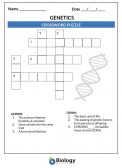 | GENETICS – CROSSWORD PUZZLE Genetics: the study of the patterns of inheritance of specific traits, relating to genes and genetic information. Print this worksheet to expand the student’s vocabulary on the common concepts and terms used in genetics. Subjects: Genetics & Evolution |
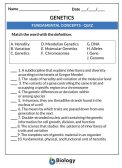 GENETICS BASIC CONCEPTS – QUIZ (pdf) GENETICS BASIC CONCEPTS – QUIZ (pdf) | GENETICS BASIC CONCEPTS – QUIZ This quiz will help you assess the student’s understanding of the various fundamental concepts and principles in genetics. Subjects: Genetics & Evolution |
Further Reading
- BiologyOnline Tutorials: Mendel’s Law & Mendelian Genetics
References
- Gregor Mendel | Biology Articles, Tutorials & Dictionary Online. (2020). Retrieved from Biology Articles, Tutorials & Dictionary Online website: https://www.biologyonline.com/dictionary/gregor-mendel/
- Mendels Law of Heredity | Biology Articles, Tutorials & Dictionary Online. (2020). Retrieved from Biology Articles, Tutorials & Dictionary Online website: https://www.biologyonline.com/dictionary/mendels-Law-of-Heredity/
- CK-12 Foundation. (2012, November 30). Fungi Reproduction. Retrieved from CK-12 Foundation website: https://www.ck12.org/biology/fungi-reproduction/lesson/Fungi-Reproduction-MS-LS/
© Biology Online. Content provided and moderated by Biology Online Editors.


